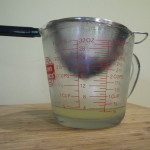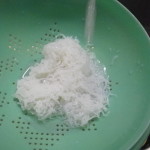 A couple weeks ago I posted about my Great Greek Yogurt Experiment, where I strained regular plain yogurt and made a simple version of Greek Yogurt. What was amazing to me was the amount of whey that came out during the straining—almost ½ the product. When I talked to people about this “experiment” the question I frequently got was “so what did you do with the whey?”
A couple weeks ago I posted about my Great Greek Yogurt Experiment, where I strained regular plain yogurt and made a simple version of Greek Yogurt. What was amazing to me was the amount of whey that came out during the straining—almost ½ the product. When I talked to people about this “experiment” the question I frequently got was “so what did you do with the whey?”
I’ll confess. I threw it down the drain.
But since so many people asked, I started investigating possible uses for this whey.
Whey from yogurt is different than whey from cheese. Sweet fluid whey is a byproduct of making cheese and contains protein, milk sugars and some minerals. There are many commercial uses for this sweet whey. The whey that comes out of the yogurt is called “acid whey”. It contains lactic acid from the yogurt fermentation, a small amount of protein and minerals.
It takes two to three times as much milk to make Greek Yogurt as it does to make “regular” yogurt so you would think you get double the nutrition. Not necessarily. Nutritional analysis shows that the Greek Yogurt has double the protein but not double the calcium. Greek yogurt is also low in potassium and magnesium. Where did they go? Into the whey.
Note: Greek Yogurt is not completely void of calcium. According to package labels 1 cup of Greek Yogurt gives you 25% of your % Daily value of Calcium where as plain regular yogurt provides 30%. Both are still excellent sources of calcium—it just isn’t double in the Greek Yogurt.
So, what could you do with this acid whey? A quick search through Google revealed that some folks use the acid whey in cooking and others put it on their plants. I’m thinking it could be easily added to smoothies for some additional liquid and calcium. Perhaps you could use it as a liquid ingredient in place if water when baking yeast products. It could be used as a substitute for buttermilk in quick breads or for marinating meat before barbequing. Try mixing it in with your dry dog or cat food (I bet some cats are too finicky for that!). Be sure to keep it refrigerated and treat as if it were a fresh dairy product until use.
I talked with an agricultural expert and he cautioned about getting too carried away using it to fertilize your indoor plants. He said, yes, it would be good for the plants, but it may also smell if you used it in large quantities—after all it is a dairy byproduct.
While making Greek Yogurt at home yields just small amounts of whey—the disposal of this acid whey is also a concern of the large yogurt manufacturers that have one to two pounds of whey for every pound of Greek Yogurt they make. Most of their “waste” whey is used by farmers as fertilizers or feed for animals.
Cheryle Jones Syracuse, MS
Professor Emeritus, The Ohio State University



